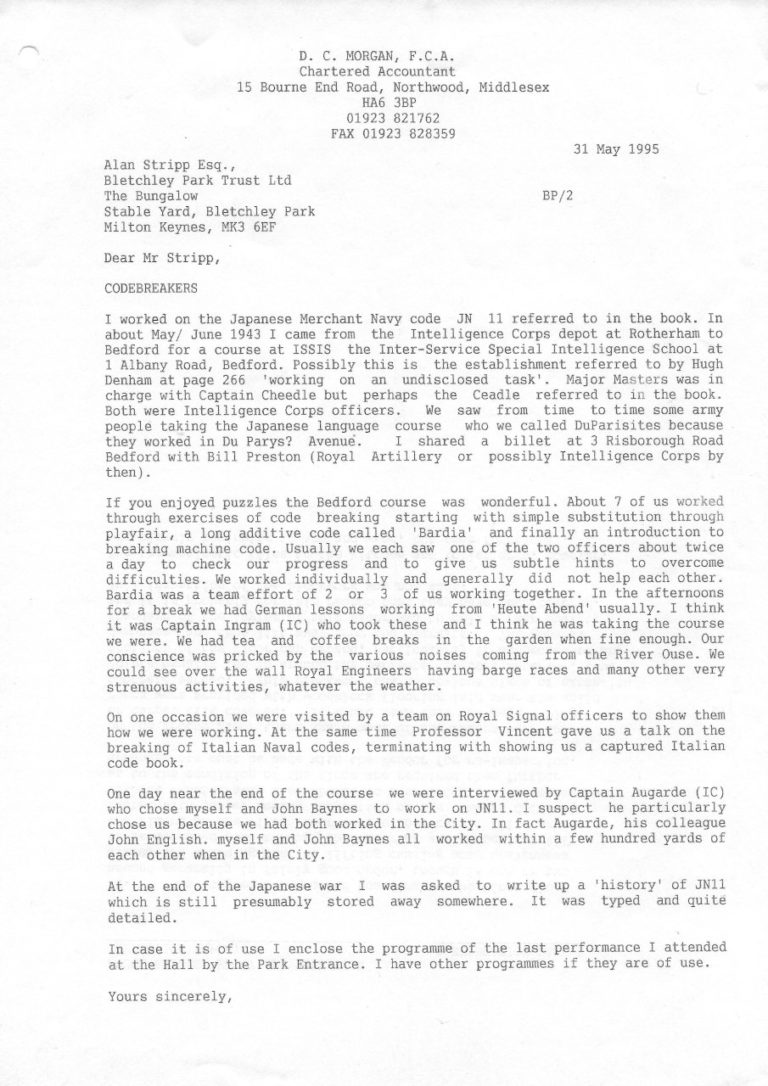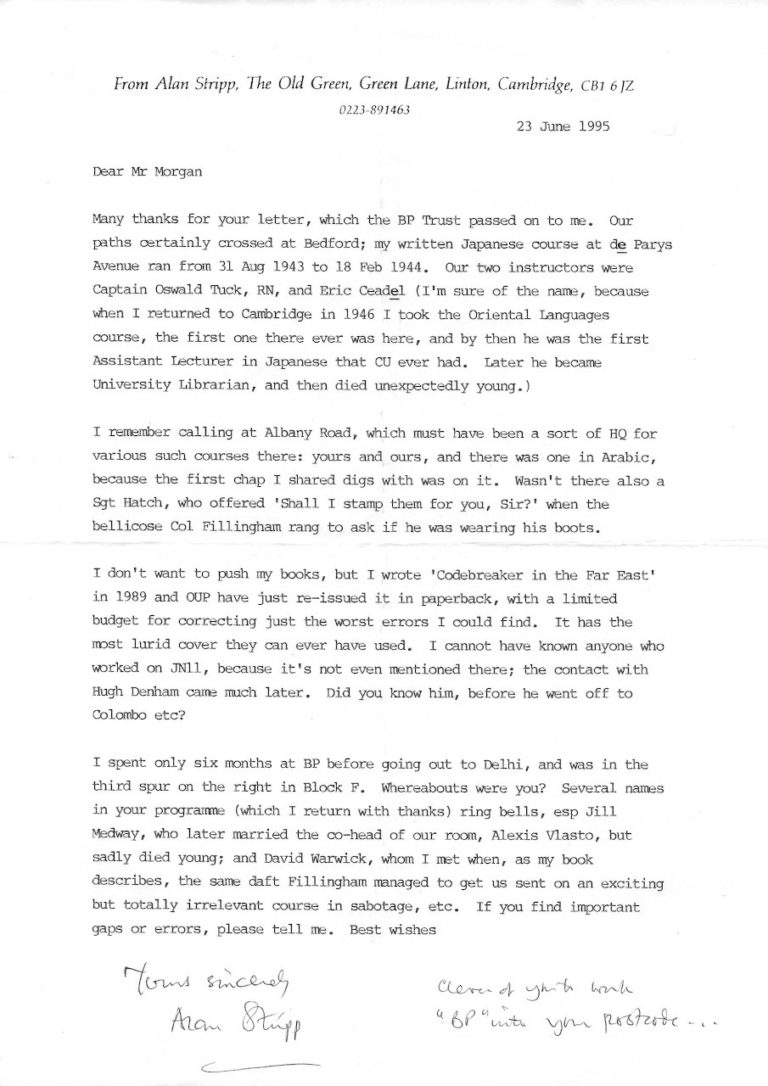Donald Morgan wrote a letter to Alan Stripp, author and historian, in 1995, which represents the only written explanation of his time at Bletchley Park before he died in 1997. The book he refers to is “Codebreakers: The Inside Story of Bletchley Park” edited in 1993 by Alan Stripp and Harry Hinsley.
Northwood, HA6 3BP
31 May 1995Dear Mr Stripp,
CODEBREAKERS
I worked on the Japanese Merchant Navy code JN 11 referred to in the book. In about May/ June 1943 I came from the Intelligence Corps depot at Rotherham to Bedford for a course at ISSIS the Inter-Service Special Intelligence School at 1 Albany Road, Bedford. Possibly this is the establishment referred to by Hugh Denham at page 266 ‘working on an undisclosed task’. Major Masters was in charge with Captain Cheedle but perhaps the Ceadle referred to in the book. Both were Intelligence Corps officers. We saw from time to time some army people taking the Japanese language course who we called DuParisites because they worked in Du Parys? Avenue. I shared a billet at 3 Risborough Road Bedford with Bill Preston (Royal Artillery or possibly Intelligence Corps by then).
If you enjoyed puzzles the Bedford course was wonderful. About 7 of us worked through exercises of code breaking starting with simple substitution through playfair, a long additive code called ‘Bardia’ and finally an introduction to breaking machine code. Usually we each saw one of the two officers about twice a day to check our progress and to give us subtle hints to overcome difficulties. We worked individually and generally did not help each other. Bardia was a team effort of 2 or 3 of us working together. In the afternoons for a break we had German lessons working from ‘Heute Abend’ usually. I think it was Captain Ingram (IC) who took these and I think he was taking the course we were. We had tea and coffee breaks in the garden when fine enough. Our conscience was pricked by the various noises coming from the River Ouse. We could see over the wall Royal Engineers having barge races and many other very strenuous activities, whatever the weather.
On one occasion we were visited by a team on Royal Signal officers to show them how we were working. At the same time Professor Vincent gave us a talk on the breaking of Italian Naval codes, terminating with showing us a captured Italian code book.
One day near the end of the course we were interviewed by Captain Augarde (IC) who chose myself and John Baynes to work on JN11. I suspect he particularly chose us because we had both worked in the City. In fact Augarde, his colleague John English. myself and John Baynes all worked within a few hundred yards of each other when in the City.
At the end of the Japanese war I was asked to write up a ‘history’ of JN11 which is still presumably stored somewhere. It was typed and quite detailed.
In case it is of use I enclose the programme of the last performance I attended at the Hall by the Park Entrance. I have other programmes if they are of use.
Yours sincerely,
D. C. Morgan
Cambridge, CBI 6JZ
23 June 1995Dear Mr Morgan
Many thanks for your letter, which the BP Trust passed on to me. Our paths certainly crossed at Bedford; my written Japanese course at de Parys Avenue ran from 31 Aug 1943 to 18 Feb 1944. Our two instructors were Captain Oswald Tuck, RN, and Eric Ceadel (I’m sure of the name, because when I returned to Cambridge in 1946 I took the Oriental Languages course, the first one there ever was here, and by then he was the first Assistant Lecturer in Japanese that CU ever had. Later he became University Librarian, and then died unexpectedly young.)
I remember calling at Albany Road, which must have been a sort of HQ for various such courses there: yours and ours, and there was one in Arabic, because the first chap I shared digs with was on it. Wasn’t there also a Sgt Hatch, who offered ‘Shall I stamp them for you, Sir?’ when the bellicose Col Fillingham rang to ask if he was wearing his boots.
I don’t want to push my books, but I wrote ‘Codebreaker in the Far East’ in 1989 and OUP have just re-issued it in paperback, with a limited budget for correcting just the worst errors I could find. It has the most lurid cover they can ever have used. I cannot have known anyone who worked on JN11, because it’s not even mentioned there; the contact with Hugh Denham came much later. Did you know him, before he went off to Colombo etc?
I spent only six months at BP before going out to Delhi, and was in the third spur on the right in Block F. Whereabouts were you? Several names in your programme (which I return with thanks) ring bells, esp Jill Medway, who later married the co-head of our room, Alexis Vlasto, but sadly died young; and David Warwick, whom I met when, as my book describes, the same daft Fillingham managed to get us sent on an exciting but totally irrelevant course in sabotage, etc. If you find important gaps or errors, please tell me. Best wishes
Yours sincerely,
Alan StrippPS Clever of you to have “BP” in your postcode…
Names and Sources
- Eric Bertrand Ceadel
- Oswald Tuck
- Stewart Ross Ingram
- Professor Eric Reginald Pearce Vincent
- Brian R Augarde
- Alexis Peter Vlasto
- Miss Hilda Joan “Jill” Medway (Vlasto)
- Mr Hugh C Denham
- David Dalrymple Warwick
- George S Fillingham
- Francis Harry Hinsley, Alan Stripp (Ed): Codebreakers: The Inside Story of Bletchley Park, Oxford University Press, 1993
- Alan Stripp: Codebreaker in the Far East, Oxford University Press, 1995
- B.P Drama Group: It’s The End, Programme, Jan 1945

